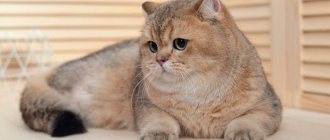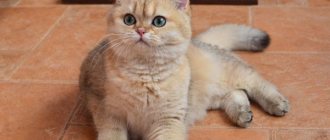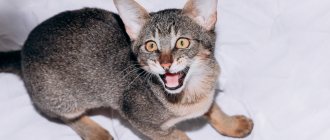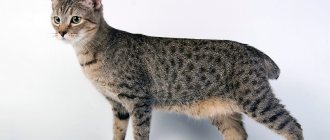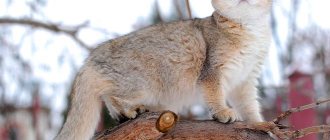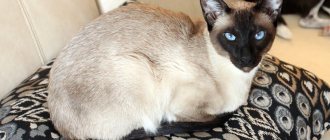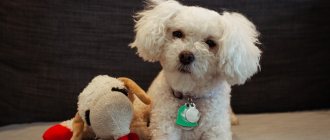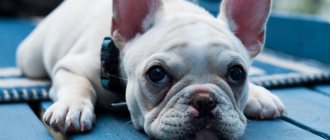It is still unclear why this cat breed deserves such a name. At the end of the 20th century, the first representatives of the Persian Chinchilla breed appeared, which did not have such a light color, but were similar in color to modern silver Persian cats. blockquote>
There is an assumption that an English breeder, by crossing a smoky cat and a silver marbled cat, opened the way for the Persian Chinchilla breed. But to achieve a beautiful light color, breeders combined Persian Chinchillas with smoky British ones. This breed gained the greatest popularity thanks to the royal granddaughter (Princess Victoria), who appreciated the incredible fur and docile nature of these felines.
Appearance
The distinctive features of the Chinchilla Persian are expressed by huge eyes and a small nose on a small fluffy muzzle. The cat attracts the attention of many because it can be quite large. A cat can weigh up to 7 kg, and its dense, thick and long hair makes its size visually even larger. The cats are more miniature (up to 4 kg), their body is correctly built, and their legs, although they have a standard length, may seem a little shorter due to their long hair.
The tail is incredibly bushy and very beautiful. The length of the hairs on it is almost 2 cm longer, if compared with the hair on the body. The color of these cats can be varied.
Color options
The following colors of Chinchilla are distinguished:
- blue;
- chocolate;
- tortoiseshell;
- red cameo;
- cream cameo;
- silver;
- golden
Recently, kittens of lilac, chocolate and tortoiseshell colors have been appearing. The fur of Chinchilla cats seems to glow from the inside, so the effect is created as if it were silver. There are also varieties of color, where part of the hair is colored blue, chocolate or tortoiseshell. Based on this, the name of the breed is formed (blue or tortoiseshell Chinchilla).
Kittens with predominantly red or cream hair color are better known as red or cream cameos. True, such colors are extremely rare. Silver and golden Chinchillas have eyes that are emerald green or a shade of sea green.
Description and features
There are plenty of exquisite cats in the world. And among the most amazing and beautiful breeds of these graceful charmers, one can highlight the silver chinchilla . It should be noted that this name was received by these cats for a very special type of plush coat with an impressive silver color.
This animal’s coat is very reminiscent of the thick fur of the cute rodent chinchilla, which has long been famous for its tenderness and play of light tints. In honor of the mentioned funny animal, this breed received its unique name.
The silver effect in such cats is created due to a light touch of dark on light fur. Visually, this gives the impression of a veil draped over the body of a four-legged creature, which also extends to the animal’s tail and its paws.
The appearance of this wonderful creature is clearly visible in the photo of a silver chinchilla . Her entire being exudes royal dignity, majestic strength and silent calm. These qualities are confirmed not only by appearance, but also by character and behavior.
Silver chinchillas have a calm character
This cat is distinguished by its flexibility, extraordinary insight and intelligence, and intellectual restraint. Such an animal does not show nervousness, does not scratch others over trifles, does not have the habit of damaging the owner’s furniture in comfortable homes, and adapts perfectly to a wide variety of conditions.
The chinchilla considers it beneath his dignity to violently express emotions: satisfaction or irritation. Natural patience gives her the ability to endure long-term loneliness. But if a beloved owner comes home, then this sweet creature will definitely find a way to express her deepest respect, devotion and love towards him.
Restraint and aristocracy are inherent in this breed even in kittens. In the morning, they tactfully wait for their patrons to wake up before rewarding them with their caresses and demanding attention and care from them. This shows the nobility of the breed.
Adult cats are incredibly smart, and even meow with a certain intonation, by which you can easily guess their thoughts, emotions and moods. Moreover, they love to communicate with their owners, which broadens their horizons and shows a desire for active improvement.
But even such domestic creatures show curiosity and activity strictly in moderation. In addition, they cannot tolerate interference from bipeds into their personal space. People can pet them, but they won’t allow themselves to be squeezed. And when they feel the need, they may well show persistent stubbornness if they see that their interests are being violated.
In this case, putting pressure on them and even persuading them is completely useless. They become attached to only one of the two-legged patrons, recognizing him as the true owner, but they love him with all the devotion of a cat’s heart.
Character and psychology
A chinchilla cat will fit perfectly into any family. All thanks to his calm disposition and aristocratic habits.
When leaving for work, the owner can be calm. The pet will not look at you with a disapproving glance. Because in his free time he will always find something to do with himself. Self-sufficiency is one of the main characteristics of the chinchilla cat family.
The chinchilla exhibits royal habits in regards to affection. The cat will come to its knees when it wants. Violent attempts will not succeed. The pet will not do what it does not consider necessary for itself.
Representatives of the cat family are not at all aggressive. They are lenient towards children's pranks. They will not allow themselves to attack a child. If the human cub goes too far, the chinchilla will quietly retreat to a safe place.
A chinchilla cat will make a good neighbor for other animals in only one case. If she appeared later. Otherwise, she will consider herself the only legitimate queen, to whom all attention should be focused. And it is she who owns all the possessions.
Potential chinchilla owners should not be afraid of the morning “hunger games”. The animal is too intelligent to allow itself to disturb its owner's sleep on such issues.
But in general, they love to have a heart-to-heart talk. The range of sounds pleasant to humans never ceases to amaze owners. An attentive owner will always be able to understand what exactly his pet wants.
How to care for your pet?
If a Persian chinchilla cat , the family will have to carefully comb its fur. Tangles and lumps will not only spoil the appearance of your pet, but will also give him unpleasant sensations. Therefore, the cat needs to be brushed daily. First you need to make movements along the fur, and then against it.
Also, the Persian Chinchilla cat requires careful eye care. Like other breeds with flattened faces, it suffers from excessive tearing. As a result, pathogenic bacteria may enter and retinal pathologies may develop. However, this can be avoided if the owner periodically washes the pet's eyes. For the procedure, special formulations are used that are sold in veterinary pharmacies and pet stores.
To prevent the animal's fur from turning yellow, it needs to be bathed frequently. For this, specialized shampoos are used. It is better to choose an option with a whitening effect.
In the Persian chinchilla breed, kittens are ready to move to a new home from the age of two months. Until this moment, they must receive mother's milk so that the babies develop immunity. Newborn kittens are cared for in the same way as cubs of other breeds.
How did the Persian chinchilla come about?
The first Persian-chinchilla cat was born in England. This happened in 1882. Even the granddaughter and namesake of Queen Victoria had a similar pet. This variety of four-legged pets was called the silver lambkin. Now the stuffed animal of the first representative of the famous breed is kept in the Natural History Museum.
The ancestors of the breed, like those of other Persians, originated from Iran (Persia). Therefore, the Persian chinchilla cat breed fully complies with the standard of the classic Persian cat.
Breed standards
The cat of the silver chinchilla breed stands out from the female cat with expressive cheeks, which is very striking. From birth, such creatures are endowed with a muscular large body, as well as a squat body, because such animals, in accordance with their characteristics, have short legs.
Other distinctive features of chinchillas are:
- straight back;
- wide chest;
- small neat ears on a round head;
- the eyes are round, large, bordered with black, green with turquoise or blue, sometimes amber;
- the nose is slightly flattened, wide, short, light brown in color with a border;
- neat, but widened paws;
- a thick short tail (according to standards, it should be half the size of the body);
- there should be hair on the paws between the toes;
- body hair shade is light with darkening,
- the back, as well as the tail and sides, are slightly darker than the main color background;
- the color is varied, it can be classic silver, but it can also be complemented by other impressive, original and rare shades: smoky, tortoiseshell, marble, gold, other colors, as well as their combinations and patterns;
- The length of the coat depends on the subspecies: it can be of medium size, there are short-haired specimens, but at the same time they are fluffier, and there are also long-haired chinchillas.
Why do felinologists and owners value the breed?
People are attracted by the noble white color of the animal's coat. It resembles the fur of an Angora cat. The animal's hair is famous for its tenderness and fluffiness.
The Persian chinchilla cat breed attracts attention with its expressive look. This is facilitated by the flattened muzzle and bright green tint of the eyes. It seems that the wool queen drew arrows on her eyelids. Other benefits of pets:
- the Persian chinchilla has ideal body proportions;
- the rounded muzzle gives the animal a good-natured appearance;
- long beautiful wool;
- a small nose is a characteristic of all Persians;
- impressive size (adult cats and female cats weigh from 4 to 7 kilograms).
The Persian chinchilla is a cat with a bushy tail. The hair on this part of the body is 20 mm longer than in other places. Therefore, the woolly king can use its tail as a fan.
Character of furry kings
The Chinchilla Persian is phlegmatic. The quiet voice makes it difficult for owners of breeding females to determine the onset of estrus. They rarely meow. They get along well with teenagers and small children. They tolerate the pranks of small family members relatively easily, although they cannot tolerate other animals in the house.
The Persian Chinchilla cat can catch mice, so it is suitable for both private houses and apartments. Loyal to her owner, following him throughout the entire space. However, escaping from home is practically impossible. If the owner does not want or cannot pay attention to his four-legged friend, he will occupy himself with play or simply doze off on his favorite blanket.
At the same time, Persian chinchillas are kittens with a curious disposition. They happily explore the world around them while walking with their owner on a harness. They love watching birds while sitting on the windowsill. In general, Persian chinchillas are calm and peaceful creatures. They pass this condition on to humans. Therefore, they are perfect for men and women whose work involves daily stress.
Education and physical activity
The mobility of Persian chinchillas directly depends on age. Kittens and young animals love to play and have no problem finding entertainment. With age, the activity of chinchilla Persians decreases. And to prevent cats from becoming lazy, it is recommended to interest them in games with a laser pointer, balls or artificial mice.
Representatives of the breed are highly intelligent and easily remember something new. Chinchilla Persians are easily litter trained and quickly learn the rules of behavior in the house.
Kinds
The ancestor of the breed, an original-colored cat named Shinny, was an inhabitant of Mrs. Hart’s nursery in England at the end of the 19th century. It was there that she was first discovered and noted as the owner of a special color, and then acquired by another breeder named Vallance for further breeding and producing offspring with a valuable trait - silver wool.
Further, one of Shinny's male descendants really became very famous, became the winner of many exhibitions, was awarded prizes and went down in history as the first chinchilla cat. It was for him that an exhibition class of such extraordinary cats was founded in 1894.
The first representatives of the silver chinchilla breed had a pure silver color, marked by an indeterminate tabby pattern, which is now commonly called ghostly or shadow. But they were few in number, and therefore to continue the family it was necessary to cross them with blue, smoky, and silver tabbies of different colors.
This interfered with the conservation of the breed. Therefore, the color of its representatives of those times could not be called established. The cats looked either too dark or unevenly colored. And only with an increase in the number of suitable applicants (around 1930) did the possibility of targeted selection become possible.
Initially, there was only the Persian (as it was later named) long-haired subspecies. According to color, its representatives were divided into “silver shaded” cats, too dark in color, and real chinchillas - lighter, the ends of whose hair were colored only an eighth of the total length.
Silver Chinchilla Persian
New specimens of the so-called ticked chinchillas have also appeared, that is, cats that do not have stripes or spots in their colors, whose hair is colored evenly, but differs in shade in different zones, which gives the effect of a slight shimmer and an impressive play of color.
Ticked chinchilla
The Persian subspecies still exists. Such specimens are distinguished by luxurious arctic fox fur, emerald eye color, a nose resembling a red brick, black paw pads and lips. In those days, this type was crossed with exotic and British cat breeds, which yielded results and the emergence of new subspecies.
The British silver chinchilla cannot boast of long hair, unlike its ancestors. It has a short coat, but its fur is famous for its thickness and fluffiness.
The coloring of such creatures, like other true chinchillas, is white with colored ends of the hair, a peculiar dark coating, the shade of which can be very individual in different individuals.
Green eyes with dark eyeliner stand out against the background of delightful fur, which makes them unusually expressive with such “makeup”.
The Scottish silver chinchilla was also bred from long-haired Persians . Typically, such specimens have medium-length hair, but, in fact, in terms of external characteristics they are not much different from the British, which is not surprising, because these two subspecies are very closely related. When breeding Scots, representatives of the British subspecies were used quite often.
Chinchilla ears can be erect, that is, the most common, and also strike a very original “owl” shape. Instances of the latter have ears tightly pressed to the head, repeating its outline, which are practically invisible.
A cat with a similar trait is usually called a silver fold chinchilla . These are considered especially exotic.
Appearance characteristics
Appearance of Persian chinchillas
Chinchillas are distinguished from ordinary Persians by their unique color; otherwise, the parameters of the breeds are the same:
- The round head appears massive due to the convex forehead, full cheeks and strong chin.
- The nose is small, wide, slightly upturned. The lobe is brick red, but the golden varieties have a paler hue.
- The ears are also small, low and wide set. The rounded tips end in fluffy tassels.
- The eyes are large and almond-shaped. The outline of the eyes and lips is outlined in black (the color of the iris in chinchillas: all shades of green).
- The coat is thick, long, thin, which is why it is silky to the touch.
- The tail consists of hairs that are 2 cm longer than those on the body, which is why it appears very fluffy.
For all their subtlety and elegance, these are very hardy cats.
Color of Persian chinchilla cats
The Persian cat, in the silver chinchilla variety, has tipping: a type of color in which only the upper 1/8 of the hair is pigmented, while the remaining part remains completely white. This color is called veiled when it seems as if a veil has been thrown over the wool, which makes the wool shimmer and sparkle.
Traditionally the tipping is dark, but in recent years breeders have developed varieties with blue chocolate, lilac, tortoiseshell, red and cream tips. The photo shows chinchilla Persians of silver and cream color.
Persian chinchillas with silver and cream tipping
In classic-colored cats, the dark pigment stands out most in the area of the ears, tail, and paws. It is characteristic that in short-haired animals the contrast in color is more pronounced. It seems as if the fur is illuminated from the inside.
Dimensions and weight
The size and weight of adult Persian chinchilla cats is 28 cm at the withers and 4 kg, respectively, males are 33 cm and 7 kg or more.
These are cats with muscular bodies and paws. They have a proportional structure, but due to the length of their fur, their limbs appear shortened. Strong bones and broad chest and shoulders add to the majestic appearance.
Kittens
The Persian breed is most active in childhood. He enthusiastically explores the apartment, attacks a fly hiding on the wallpaper, or disappears into the wilds of the country lawn, revealing ancient instincts. Early returns may be susceptible to food allergies, so try to introduce them to quality dry food.
How long do Persian cats live? Pets may be susceptible to skull deformation, eye diseases, and have breathing problems
. But one way or another, the average life expectancy is 14-15 years. There is an opinion that male Persians are more active and aggressive, while females are docile and gentle. But in reality this is far from the case. It is the female Persians who show greater independence and autonomy. You should take this fact into account when purchasing a pet.
Interesting!
The average cost of a Persian cat in the world is from 300 to 800 US dollars.
Care and maintenance
These creatures, who tend to behave with true royal dignity, in everyday life turn out to be far from being as demanding and picky as it might seem at first.
A big advantage of the breed is that by nature its representatives are endowed with quite good health. However, the care and nutrition regimen should still be followed in order to protect such noble pets from troubles and diseases.
And the first point that should be noted as requiring special attention is the need to monitor the magnificent fur of such pets. Regardless of whether the cat's fur is long or short, it must be combed at least a couple of times every seven days.
The silver chinchilla's coat needs to be brushed once a week.
This procedure is undoubtedly important because excess hair negatively affects the well-being of such high-breed creatures. In addition, it is clear that wool in the house, left in different parts of the home: on furniture in rooms, carpets on the floor and clothes of the owners, does not have a positive effect on the hygiene of the room, and can also cause an allergic reaction.
Another important procedure is monthly bathing. And after this, it is recommended to examine the animal’s eyes, teeth and ears for contamination and the presence of inflammatory foci in them. This is important especially in the summer, because the heat makes it difficult for the cat to breathe and also provokes unwanted discharge in animals. What becomes a consequence of purulent inflammation.
It is better for the owner if he makes it a rule to treat such a sensitive and intelligent pet without irritation, violence, screaming and pressure. Otherwise, the reaction to injustice in a silver chinchilla cat may turn out to be the most unpredictable.
She is independent and loves freedom, and, therefore, she needs personal space - her own camphor and cozy corner for relaxation, which should be equipped with love and taking into account the animal’s personal preferences.
Care instructions
Persian chinchilla after grooming
What makes this breed beautiful are its large green eyes and long, silky coat. With proper care, the cat will feel comfortable and will not harm itself.
- Wool. The breed's peculiarity (short tongue) does not allow the Persian to fully take care of his beautiful fur, so he needs the help of his owner. It is recommended to comb out every day, using a slicker brush and a comb with sparse metal teeth. First, in the direction of hair growth (tummy, chest, hind legs, head, back, tail), then, if necessary, against hair growth. If tangles have formed, they are usually cut off. You should also comb the fur between your fingers: matted fur causes great discomfort when walking.
- Bathing. No more than once every two months (if the cat is exclusively at home). For water treatments, choose a specialized shampoo for long-haired dogs; it will minimize the likelihood of tangles forming. To make their fur shiny, show chinchillas are additionally washed with tint products for light fur. Be sure to rinse thoroughly and blow dry your pet to remove any dead hair. If your cat is very afraid of bathing, use dry shampoo and clean dirty areas with a damp cloth. It is strictly not recommended to use human means. The presence of strong flavors, additives and other products that are harmless to humans can have a negative impact on your pet’s health.
- Eyes. The flattened muzzle and poorly formed eye canal lead to frequent tearing in Persians. In this case, they are at high risk of becoming infected with pathogenic bacteria. To prevent the onset of the inflammatory process, it is recommended to wipe the eyes with a sponge soaked in eye drops, chamomile decoction or saline solution.
- Ears. The same as with the eyes. Once a week it is necessary to treat them with a cotton pad and a special solution.
- Claws. Trim once a week if your pet does not sharpen them themselves.
- Teeth. If necessary, clean with a cat toothbrush and toothpaste. For complete health, it is recommended to remove tartar with ultrasound once a year.
The cat's litter box also requires care. In addition to regular cleaning after the cat has visited it, once a month you can pour boiling water over the tray.
Diseases
Following basic hygiene rules will reduce the risk of your pet contracting some dangerous diseases. When you come from the street, wash your hands immediately. Do not approach the cat in outerwear. The same applies to shoes: they can easily bring pathogens from the street. First of all, this applies to cats that have not yet been vaccinated.
A peculiarity of Persians is snoring during sleep. This is a feature of the body associated with congenital deformation of the nasal septum, so do not panic.
- Eye infections occur frequently in Persians. The treatment method is chosen by the veterinarian: in some cases medication is sufficient, in others only surgery will help.
- Polycystic kidney disease is the formation of cysts on the organ. Causes kidney failure. Maintenance therapy is recommended.
- Gingivitis and periodontitis are also quite common. If the disease is advanced, only tooth extraction will help.
- The special structure of the nasal passages leads to frequent colds. The cat should be protected from hypothermia: do not allow it to sit in a draft, dry its fur with a hairdryer after bathing, do not feed food from the refrigerator, and do not walk in bad weather.
- Hypertrophic cardiomyopathy is a thickening of the heart muscle. The cat begins to get tired quickly, cough, breathe heavily and moves little. It is impossible to cure the disease, but drug maintenance therapy can significantly alleviate the condition and prolong life.
- Dermatitis is characterized by the appearance of brown discharge around the nose and eyes. The hair in these areas falls out, the skin turns red and swells, which is why the cat experiences discomfort and constantly tries to scratch this area. It often spreads to the ears. Occurs mainly in young animals. Medicines can achieve remission, but without proper control the disease develops again.
Nutrition
The menu of such a cat must be varied. But in the diet it is important not to mix homemade food and artificial food, but to immediately choose one of the above. If preference is given to the latter, in this case, when choosing food, it is necessary to take into account the condition of the body, the size and weight of the pet.
Only with this approach will it be possible to select a suitable product in the store. Therefore, for advice on proper nutrition, it would be a good idea to immediately contact a veterinarian who is knowledgeable in these matters.
In general, the body of chinchilla cats is perfectly adapted to digest and accept the meat of rabbit, turkey or chicken. Moreover, such dishes can be served to your pet either boiled or raw, but it is better to cut the meat pieces for lunch into smaller pieces.
You can include fish dishes in the menu, however, not too often, because a couple of times every seven days will be more than enough. You can also give chinchillas low-fat cottage cheese, yoghurts, kefir, but again not in excessive quantities. Vegetables include cabbage and carrots, and the healthiest porridge for a cat may be buckwheat.
As for the diet, the most ideal would be two meals a day (for young cats - three times a day) meals. To ensure that the fur of a magnificent chinchilla is always in the best condition, such creatures need vitamins.
By the way, there are a lot of them in regular artificial food for kittens. However, such diets should again not be abused.
Health
In general, chinchilla cats can boast of good health. However, some hereditary diseases have not escaped them.
See also: American Shorthair cat
Polycystic kidney disease. Unfortunately, the disease is almost invisible in the early stages. In the later period of the disease, the animal’s abdomen increases in size and pain occurs.
Hypertrophied cardiomyopathy. Ultrasound will help identify the disease. The first symptoms are fatigue and shortness of breath.
Retinal atrophy. The eyes of a chinchilla are a kind of “Achilles heel” of the animal. Increased tear production and lack of regular care together can lead to complete blindness of the pet. Extremely dilated pupils and an unnatural shine in the eyes indicate that it is time to consult a veterinarian.
With proper care, the average life expectancy of chinchilla cats is twelve to fifteen years.
Mating
The process of breeding chinchilla cats is quite labor-intensive. Obtaining the signature color of an animal is possible only by mating with a partner who has a similar color and belongs to the same breed. However, even an accurate calculation cannot guarantee a stable characteristic color of the offspring. Therefore, the process of breeding chinchilla cats is called alchemy.
If the future offspring does not lay claim to the laurels of the winner of cat shows, then you can choose a pair based only on the breed.
In order to qualify for participation in performances, it is necessary to choose a partner who has an ideal pedigree and a standardized color. The ideal solution would be to turn to professional breeders.
It is recommended to start mating no earlier than the animal reaches one and a half years old.
A peaceful, calm state of the cat will indicate that the mating was successful. The process of pregnancy and childbirth, as a rule, occurs without complications. Chinchilla babies are born after nine weeks.
The chinchilla cat is a charming, cute pet that makes you fall in love at first sight. The unique appearance is complemented by a friendly character and aristocratic manners. In addition, the cat is not at all averse to having intimate conversations with its owner. Why not a contender for the title of ideal pet?
Reproduction and lifespan
Selecting a suitable partner for cats of this breed, if you want to get offspring with the required hair quality, is not an easy task and requires a lot of knowledge in the field of animal breeding.
The silver type color is divided into several groups:
- darkened silver (the colored tip of the hair is no more than an eighth of the length);
- ticked (with alternating several light and at least three dark zones on the hair);
- silver shaded (colored at the tip for a third of the length).
Errors in selecting pairs for mating can result in the appearance of silver chinchilla kittens with undesirable hair color. This makes it difficult for the breed to develop. And restoration of the necessary qualities takes two, or even three generations. At the same time, the progressive features of purebred chinchillas may be completely lost.
The problem is also the eye color of these cats. Initially, it was believed that in purebred representatives it must be turquoise (greenish-blue). Later, bright yellow and orange eyes were accepted as acceptable.
But although there are more than enough difficulties, however, thanks to the efforts of breeders and the hard work of breeders, the chinchilla breed is constantly being improved. And even if the kitten does not become a prize-winner at exhibitions, it still pleases its owner.
Such a sublime creature, captivating hearts at first sight, will decorate any home and easily make friends with its inhabitants. The approximate lifespan of such pets, which are naturally in good health, is approximately 15 years.
What color can a Persian chinchilla be?
The Persian chinchilla is a snow-white cat. However, there is a veiled variety of color. The animals have pigmented tips of their hairs. Therefore, several shades are possible:
- Persian silver chinchilla (blue);
- black;
- tortoiseshell (typical of females);
- chocolate;
- apricot or yellow;
- lilac.
The Persian silver chinchilla , as well as the golden variety, are especially beautiful. They seem to be wearing light tulle or gauze dresses. The nose of a creature of this color is lighter than that of other color variants. They are characterized by beautiful eyes of bright green or bright blue tones.
Consequences of suppressing the natural instincts of an animal
We should not forget that such procedures (castration and sterilization) are not only beneficial, but can also cause harm. It is known that after surgery aimed at suppressing the physiological needs of a feline, animals can gain extra pounds. Therefore, such a pet’s diet will need to be monitored for the rest of its life, in order to avoid serious health problems: obesity, shortness of breath, heart failure.
In this case, the answer to the question of how long castrated cats live at home will depend entirely on the person who competently builds the right diet for the pet with a minimum content of proteins and fats.
Price
In Russia, few specialize in this breed. In total, no more than six breeders are engaged in chinchilla cats. Those who have decided to purchase a kitten of such a wonderful breed should know that representatives of its price category occupy the average.
Purebred specimens, which can subsequently be presented at exhibitions and used in breeding, will cost future owners no less than 70 thousand rubles.
There is also a cheaper category of chinchilla kittens, which are estimated at 30 thousand. As a rule, such specimens of the breed, from the point of view of experts, have some kind of flaw, and they are not intended for breeding and showing.
Owner reviews
Kate
I was given a golden British chinchilla for my birthday. This is probably the best gift of my entire life, my miracle. She's just like a toy, plush fur. And her chic golden color simply does not allow you to take your eyes off her. She has already become a member of our family. I feed her Royal Canin. She likes. It is clear that the food has arrived. Her coat is shiny, and she herself is very active. You really get fat quickly.
Marina
Our neighbor upstairs has a chinchilla cat. They bought it at an exhibition somewhere. I think this breed of chinchilla cat is called the British Silver. The neighbor doesn’t let him outside because we have a lot of ordinary cats in our yard, she’s afraid of ruining his pedigree. Sometimes the children and I go to see it. It's just lovely. His silver fur and very bright eyes make him look like a doll. It seems that he is not real. He meows very rarely, such a calm, beautiful cat. Of course, we won’t buy one for ourselves, because I’m afraid the children will squeeze it. And so, of course, we are all in love with our neighbor Patrick.
Zoya
I never knew before that there were such beautiful cats. When my husband showed me a golden chinchilla cat on the Internet and asked if I wanted one, I replied that, of course, yes. We went to look for one of these in nurseries, but it turned out to be not so easy. Such a handsome golden man costs a lot of money. He is easy to care for, we feed him special food, sometimes we give him cottage cheese and fish. Now she’s thinking about buying another silver chinchilla, but I’m afraid that they might quarrel.
Tatiana
There is a woman living in our building who bought a golden chinchilla cat at an exhibition. She took a very responsible approach to choosing a pet and always wanted to participate in exhibitions with this cat. When she brought it home, we asked to see it. I have never seen such beautiful cats in my life. The cat is not just golden, it is some kind of copper-peach-gold. Each of his hairs is stretched with a gradient of color. And to the touch it is just an incredibly soft plush toy. Now the cat is 2 years old and his owner takes him to various exhibitions, where he sometimes wins first places.
Video
The age-old question regarding feeding
The lifespan of any living creature, not just a cat, is influenced by a proper diet, which ideally should be complete in all respects. Veterinarians recommend feeding your pets dry food to the exclusion of all other additives. The main rule is that the food must be premium or super-premium. According to professionals, this is the diet that can give an animal many years of a happy life.
Ordinary people: experienced breeders or those who bring a cat into their home for the first time are of the opinion that it is not better to find “live” food. Sometimes they even combine “drying” with cereals, meat or something else, considering this approach to be correct. From a scientific point of view, from such feeding the animal is slowly destroyed, not receiving the necessary nutrients and acquiring many diseases. The reason is that dry food produces certain enzymes in the pet’s stomach that are unable to digest “live” food and vice versa. Therefore, those who want to bring a small kitten into their home should study the issue of proper feeding thoughtfully and in detail.
What to feed the animal?
High-quality nutrition is the key to excellent health for your pet. Therefore, a person must approach his menu responsibly. It would be best to consult a veterinarian, although there are general recommendations for the diet of these cats:
- You can use industrial dry food. Its quality must be at least premium. There is a special diet for Persian and British Shorthair breeds.
- Suitable meat types include beef, chicken and turkey. It is better to boil the fillet.
- A four-legged creature's menu must include vegetables. Sometimes you can buy vitamin supplements based on your veterinarian's recommendation.
- Lean sea fish is a must for animals. However, it should be no more than 10 percent of the cat’s entire menu.
- Boiled eggs are rich in proteins, so you can safely offer them to your Persian.
- Beef and chicken by-products (liver, heart, kidneys) are rich in vitamins and microelements. Therefore, you can treat your furry friend with them.
- Bone meal is an excellent addition to an animal's menu.
The Persian chinchilla cat is demanding, but will thank its owners for their care with longevity and a peaceful purr.
Types of Persian cats
Persian cats were domesticated several centuries ago, and since then their appearance has undergone many changes. Thanks to breeders, today there are several types of this breed.
Depending on the color, there are about 100 varieties. Cats can have a single color, or they can consist of several colors and shades.
The most noticeable distinguishing feature in the description of a Persian cat is its nose. It is small, wide and snub-nosed. There are several types of Persian noses. Depending on its type, there are several types of Persian cats:
- Classic British - straight nose, located just below eye level
- European - snub nose, the upper edge of which is at the same level as the lower eyelids
- Extreme - snub nose, which is located on the same level with the upper eyelid.
Previously, there was another type of Persian cat - peakface. Their nose was located above the level of the upper eyelid. Their breeding was prohibited due to significant health problems
These cats have: breathing problems, constant lacrimation, malocclusion, problems eating. Such cats lived very rarely. The extreme type of Persians is the result of selection taking into account the rules of humane treatment of animals.
Origin story
The chinchilla breed originates in Great Britain. It was there that the first Persian cat with an unusual color was born - Sheena. Breeders paid attention to the baby in 1882, which was the beginning of breeding work.
Sheena's owner chose a cat with a suitable color for her pet. From these matings two litters of silver kittens were born. They were exhibited quite successfully, but did not leave offspring (at least there is no data on this). The first officially registered chinchilla cat appeared as a result of crossing the Betty cat with a smoky male.
The selection continued. Due to the small number of individuals of this variety, the descendants of the first chinchilla began to be crossed with purebred British. To fix the bright green color of the eyes, tabby blood was added. At first, the kittens were born dark, they looked more like blue-gray British cats. Over time, breeders managed to achieve a pearly sheen.
Initially, this color was considered an advantage of exclusively long-haired cats with pronounced Persian roots. By the 1970s, this coat color began to be taken into account in British and some other cat breeds.
Experts are still arguing about whether chinchillas should be considered a separate breed or a subspecies of Persians. Be that as it may, this color was the first to be specially selected. He is assigned by breeders, but without qualifications.
